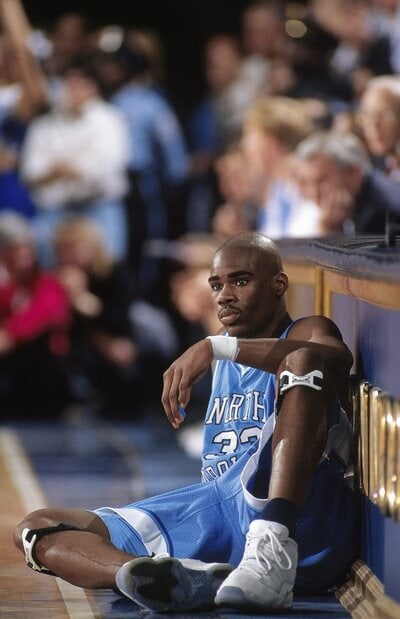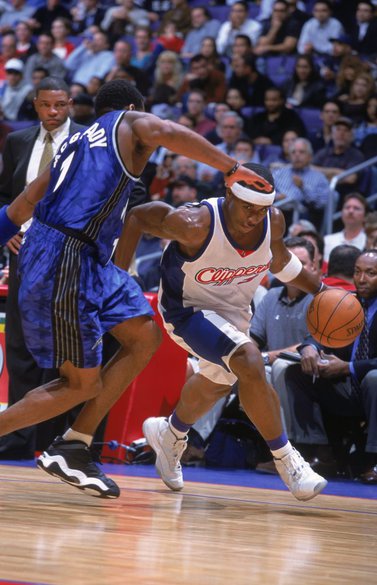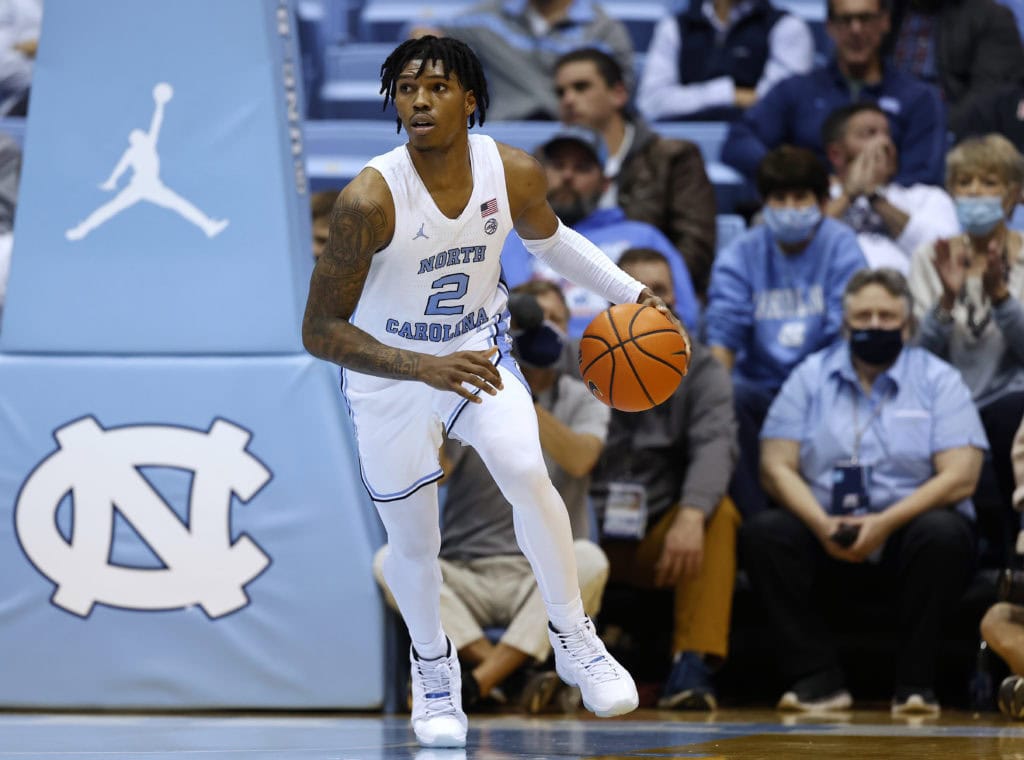Last launched under the “Legend Blue” moniker in 2014, an OG classic from Mike’s playing days is reportedly returning in 2023. Let’s set the scene with a Jumpman history lesson.
Just as NBA trade rumors spark the possibility of super teams, sneaker release leaks lend themselves to footwear fantasies. This past week, the Internet was set ablaze by internal line sheets at Jordan Brand becoming public (as they often do) as divulged through Photoshop previews of the Summer 2023 launch lineup.
Thanks to the due diligence of @zSneakerHeadz, a social media maven and YouTube creator with an unmatched batting average on early intel involving Jordan release dates, sneakerheads far and wide are saving up and planning outfits months in advance.
And while new takes on old favorites always promise intrigue, the crown jewel of next year’s early entries appears to be the return of the “Columbia” Air Jordan 11.
Worn by Michael Jordan in the 1996 NBA All-Star Game and last seen in retro form by way of 2014’s “Legend Blue” bring-back, the patent leather pair is yet to return in remastered form with the famed original cut.
Even more interesting, this mid-top makeup of the acclaimed Air Jordan 11 is said to return in the summer months — a rarity as far as this holiday hit is concerned.
So, why does this shoe matter so much to collectors prior to actual confirmation from Jordan Brand and close to a year before they’re even rumored to return?
Let’s take a step back. As with any pristine pair from MJ’s playing days, the Jordan 11 Columbia kicks are loaded with history.
From California to Carolina
The origin story of the Air Jordan 11 Columbia begins not in the United Center, but rather in the Sherman Oaks neighborhood of Los Angeles.
Back to basketball but moonlighting as a movie star, MJ spent the summer of 1995 in what’s now known as the Jordan Dome: the basketball court and weightlifting facility Warner Bros. built on the set of Space Jam.
Hosting famous friends like Magic Johnson, Dennis Rodman, Juwan Howard, Reggie Miller, and more, the GOAT looked to get back in game shape between shoots with the rabbit, reeling for revenge after an Orlando upset in the 1995 NBA Playoffs.
Putting in work with Tim Grover and the game’s greatest competition, Mike channeled his Chapel Hill days by wear-testing his new signature shoe with matching North Carolina game shorts.
Though first seen on Mike’s feet in black and white shots from the Space Jam set, the Columbia 11s actually made their NBA debut on Nov. 14, 1995, on Orlando’s Nick Anderson. With Mike in the “Concords,” the Bulls took their first loss of the season — one of only 10 losses during that historic season.
Months later, seeded styles made their way to North Carolina junior Jeff McInnis and freshman forward Antawn Jamison days prior to their Feb. 1, 1996, retail release. Breaking them out at home in a nationally televised win over Duke, the alma mater move was part of Nike’s somewhat new five-year, $4.5 million endorsement deal with the school.

Days after their UNC christening and retail arrival, Michael made them his own again by wearing them in the 1996 NBA All-Star Game — his first appearance in the showcase since ending his baseball sabbatical. Fittingly, Mike won game MVP honors, and fans of all ages would follow in his patent leather footsteps.
Since their inception, the Columbia 11s have cultivated somewhat subtle fanfare compared to their counterparts, but their folklore is utterly unique. The quiet color blocking and UNC nuances of the Columbia colorway make them more of a niche fascination than their “Concord” cousin and less durable than their “Playoff” partner, but when it comes to sheer relevance, they hit hoops history and the pop culture pantheon in all the right corners.
Superfans will recall a high schooler named Kobe Bryant breaking out pairs as a standout at Lower Merion. Famously, Will Smith wore Jordan 11 Columbia kicks in the series finale of The Fresh Prince of Bel-Air. All this adds to the legend.
However, it’s just the first chapter of the storied shoe.
Back for the First Time
The retail release of the Air Jordan 11 in 1995 and ’96 threw gasoline on glowing embers.
While Tinker Hatfield crafted the “Jordan Beyond” behind the scenes, his teammates at Nike like Eric Avar, Wilson Smith, and Aaron Cooper went absolutely HAM in their attempts to save the basketball brand in what was thought to be a post-MJ world.
Releasing regarded signature shoes for the likes of Penny Hardaway, Sheryl Swoopes, Scottie Pippen, Jason Kidd, and more, the creative explosive was only magnified by Mike’s return and the release of the AJ11. In following seasons, Mike’s swan song in Chicago played exactly to script, winning three more NBA titles and debuting four more made-for-MJ models. In his final season, Nike granted the best baller ever with his own subsidiary, the Jordan Brand.
Exiting the game on top in ’98 and looking to create a cache for his company away from the court, the brand released team shoes tied to Eddie Jones and Vin Baker, as well as modern models made in Mile’s image. To add more momentum, they began bringing back coveted colorways of Air Jordans from the past while also introducing new takes on old favorites.

But rather than wait a decade to return the Air Jordan 11 — a somewhat standard protocol for retro releases at the time — Jumpman cut the cycle in half by bringing back the patent leather classic only five years after its debut.
With the internet in its infancy, however, this sort of news would often arrive under the radar. First looks were often found in the back pages of SLAM Magazine or on the feet of the newly signed Jordan Brand elite.
“[In 2000] people don’t even know it’s coming because there’s no social media telling you about the Jordan Brand lineup for the fall,” 13-year NBA veteran Quentin Richardson told Boardroom in December 2021. “A lot of times, they just saw it on us. People knew who we were at this point so they knew it was legit. They’d lose their shit and ask to take pictures with us and we’d just bask in the glory.”
As a rookie for the Los Angeles Clippers, Q-Rich and running mates Darius Miles and LaMar Odom rocked retro Jordans early and often. Weeks before fans even knew the “Columbia” 11s were coming back, the Chicago-born sharpshooter was putting on pairs for NBA action.
“When you get the Elite Package from Jordan Brand, those weren’t shoes they sent you to play in,” Richardson said, “so I immediately called and ordered two to three more backup pairs for the crib.”
Originally, retro releases from Jordan Brand were intended to transition old classics on-court to new favorites in fashion. Even still, the temperature around the AJ11 was so hot that fans from generations past and present had to lace up pairs on the hardwood and in the hallway.
“I always felt like the best shoes are the ones that work on and off the court,” former Jordan Brand Vice President Gentry Humphrey told Boardroom last December. “You’ve got generations that have grown to fall in love with that shoe. The fever today is probably hotter because of sheer numbers.”
On Jan. 17, 2001, the Air Jordan 11 Columbia sneaker returned to retail to rave reviews. The enduring heat surrounding the silhouette gave life to the retro products and even created an early climate for resale, with fans often paying over box price on drop date just to make sure they had a piece of history.
At that time, it was unclear from a consumer standpoint whether retro releases were a sole second chance on originals thought to be one-and-done or something that would happen with regularity. Where the Columbias were concerned, both notions would prove true.
Over the course of the 2000s, the Jordan 11s were released in an array of colors both old and new. By the mid-00s, they were reserved as a holiday special, allowing Jordan Brand to close out the fourth quarter of each year with a bang.
While a slew of styles painted in patent leather would drop over the course of that decade, fans would have to wait years on end for another chance at the Columbia colorway.
A Retro Rebrand
If the Air Jordan 11 was hot in the ’90s, it had even more magma and magnitude in the ’00s, and by the 2010s, it was scorching as sneaker collecting had gone massively mainstream with the perceived value of sneakers skyrocketing miles above MSRP.
After chaos ensued over the retro re-release of the Air Jordan 11 “Concord” and “Playoff” — both original colorways that had come back before — the brand broke the cycle of revered classics by launching the off-kilter “Gamma Blue” 11 in 2013. Released to mixed reviews but becoming increasingly popular with time, it was all a set-up for the return of the “Columbia” colorway.
However, there would be a slight twist.

Due to legal issues surrounding the term “Columbia” and the Ivy League university with which it shares its name, Jordan Brand rebranded the Carolina-linked classic under the “Legend Blue” moniker.
In an effort to upend the aging process seen on translucent soles that turn yellow over time, a bright blue tint was added to the outer as a means of longevity. And while the pairs performed well, selling out in a manner of minutes and ending up under many a Christmas tree, some purists felt as though they’d missed out on the Real McCoy.
To make matters worse from at least one point of view, Jordan Brand brought its Remastered Retro campaign in Jan. 2015 — mere days after the Legend Blue 11 launch — as a means to reset shape, standard, and price on archival comebacks.
In many ways, releasing an almost all-white sneaker in the middle of December was an odd spot for sneakerheads as was the change of the guard in quality control. Oddly enough, this made many Legend Blue 11s an easy transition from status symbol off the court back to a ball shoe on the court. From the pro game to the college game and every level down, the AJ11 was back as a basketball shoe even if that wasn’t necessarily Nike, Inc.’s intended marketing angle at the time.
Since the release of the Legend Blue 11, Jordan Brand has brought back revered colorways of the patent leather classic like the “Concord,” “Space Jam,” “Playoff,” and “Cool Grey” styles with the cut and craftsmanship seen on the same styles Mike once wore in the Jordan Dome.
Thus far, the only original not to receive such treatment is that of the Columbia colorway.
If recent leaks prove accurate, that could all change soon.
Same Style, New Market
Whether or not the Air Jordan 11 returns as a retro with its original Columbia handle or the Legend Blue branding in 2023 is of little meaning to sneakerheads. If the shoe is simply done right, it will prove a win for all involved.
What will be different this round based on early accounts, however, is the timing. Typically, a mid-top Air Jordan 11 is reserved for the holiday season, as it’s known as a Christmas shopping crown jewel. In recent years, the Air Jordan 1 has replaced its shiny successor as the most sought-after shoe from MJ.
By releasing the almost all-white OG AJ11 in the summer, Jordan Brand can quickly conjure just how much heat still surrounds the decades-old design. In recent years, the brand has been brilliant in producing much more pairs than ever before, selling through with ease while avoiding the hysteria (sometimes veering into violence) that once surrounded the shoe’s history.
According to Farfetch, Air Jordan 11 retro releases accounted for $140 million in sales in 2001 alone. Years later in 2019, the Air Jordan 11 “Playoff” Retro was reported to be the best-selling shoe in Nike history, said to have sold out in 28 minutes on the company’s SNKRS App.
For years, retro releases moved the needle more on the spectrum of sneaker hype than that financial reports for sneaker company shareholders. However, that all changed by 2016 when both the Air Jordan 11 and Air Jordan 12 cracked the top 10 among the biggest-selling sneakers of the entire year.
For Jordan Brand, a company that turns 25 this month, the sustained success of the Air Jordan 11 is a key reason why they generate more than $5 billion a year; not only is its patent leather legacy competing with designer brands in regard to cool cachet, but it’s doing the same numbers as mall models marketed towards Middle America.

If the Air Jordan 11 Columbia ultimately returns in the remastered retro form in Summer 2023, the Jumpman has plenty of good energy surrounding it. Ideally, Mike’s alma mater of North Carolina will be making another deep tournament run after reaching the NCAA title game last season. It wouldn’t be difficult to envision star combo guard Caleb Love leading the way in various colorways of the thematic classic.
Currently in the midst of a 10-year extension worth $6.27 million per year as reported by Forbes in December 2018, both Brand Jordan and UNC have plenty of reasons to leverage their loaded likeness across all platforms. Even more importantly, the company can hit the same annual jackpot they pull off in Q4 earlier — and perhaps more often. A summer Air Jordan 11 release clears the runway for a new colorway to come in December. Alternatively, it clears a path for the Air Jordan 1 to ascend as its holiday season successor.
In either event, if Jordan Brand already has us thinking about a summer sneaker months before it’s even confirmed, they have our attention already — and soon, our dollars.